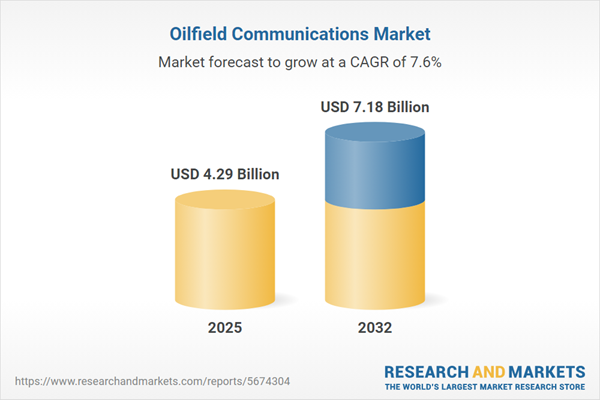Speak directly to the analyst to clarify any post sales queries you may have.
The Oilfield Communications Market is undergoing rapid transformation as digitalization and advanced networking become central to oil and gas operations. Reliable communications infrastructure now underpins everything from asset management to safety compliance in today’s resource extraction landscape.
Market Snapshot: Oilfield Communications Market Growth and Opportunity
The Oilfield Communications Market grew from USD 3.98 billion in 2024 to USD 4.29 billion in 2025. It is expected to continue growing at a CAGR of 7.63%, reaching USD 7.18 billion by 2032.
Increasing reliance on digitalization, robust connectivity across remote and offshore sites, and the demand for integrated, resilient communication solutions are key drivers. Senior leaders are focusing on infrastructure investments that enable real-time data transmission, predictive maintenance, and safe automated operations.Scope & Segmentation
This report provides detailed analysis across the oilfield communications landscape, examining essential segments and covering major global regions and technologies:
- Component: Hardware, Services, Software
- Technology: Wired Communication (Coaxial Cable, Ethernet Cable, Fiber Optic), Wireless Communication (Cellular Communication, Microwave Communication, Radio Communication, Satellite Communication)
- Application: Automation Control (Drilling Automation, Remote Valve Control), Data Management (Data Acquisition, Data Analytics, Data Storage), Field Operations Support (Logistics Coordination, Safety Management), Real-Time Monitoring (Flow, Pressure, Temperature Monitoring)
- End User: Downstream (Distribution, Refining, Retail), Midstream (Processing, Storage, Transportation), Upstream (Development, Exploration, Production)
- By Region: Americas (United States, Canada, Mexico, Brazil, Argentina, Chile, Colombia, Peru), Europe, Middle East & Africa (United Kingdom, Germany, France, Russia, Italy, Spain, Netherlands, Sweden, Poland, Switzerland, United Arab Emirates, Saudi Arabia, Qatar, Turkey, Israel, South Africa, Nigeria, Egypt, Kenya), Asia-Pacific (China, India, Japan, Australia, South Korea, Indonesia, Thailand, Malaysia, Singapore, Taiwan)
- Key Companies: Speedcast International Limited, Inmarsat plc, KVH Industries, Inc., ORBCOMM Inc., SES S.A., Intelsat S.A., RigNet, Inc., Iridium Communications Inc., Viasat, Inc., Eutelsat Communications S.A.
Key Takeaways for Oilfield Communications Decision-Makers
- Technological integration is central, with ruggedized hardware and software-driven platforms unlocking new levels of operational visibility and accelerated field decision-making across oilfields.
- Combining cellular, microwave, satellite, and legacy wired networks facilitates seamless and continuous data exchange even in the world’s harshest environments.
- Operators leverage automation, artificial intelligence, and machine learning to minimize downtime, boost safety, and support predictive maintenance strategies in real time.
- End-to-end service offerings that unify installation, maintenance, and cybersecurity have become the norm, ensuring resilient and scalable operations from upstream drilling sites to downstream distribution hubs.
- Regional strategies are adapting to local regulatory requirements, compliance frameworks, and challenging geographies, reflecting a shift toward flexible, interoperable communication architectures across all continents.
Tariff Impact on Oilfield Communication Infrastructure
Recent US tariff adjustments on imported communication equipment are driving strategic shifts in procurement and supply chain management. Operators and manufacturers are revisiting sourcing practices, increasing local and nearshore production, and negotiating contract terms to address cost pressures and compliance. This environment has further accelerated investments in domestic manufacturing capacity and prompted the bundling of services to mitigate budget volatility resulting from fluctuating hardware costs.
Research Methodology & Data Sources
This report utilizes a robust mixed-method research approach. Primary insights were gathered through in-depth interviews with key industry stakeholders, complemented by an extensive review of public documents, technical white papers, and regulatory filings. Data triangulation ensured reliability, while quantitative analysis and validation with subject matter experts provided operationally relevant findings.
Why This Report Matters
- Enables leadership to benchmark their operations against evolving global best practices in oilfield communications.
- Supports informed technology and service procurement decisions by illuminating segmentation, operational trends, and regional adoption paths.
- Equips decision-makers to respond proactively to regulatory shifts, including US tariff impacts, and changing connectivity requirements.
Conclusion
The oilfield communications sector is entering a transformative phase, where innovation and operational priorities converge. Leaders leveraging integrated, adaptable network strategies and fostering strategic partnerships will be best positioned for sustained operational resilience and competitive advancement.
Additional Product Information:
- Purchase of this report includes 1 year online access with quarterly updates.
- This report can be updated on request. Please contact our Customer Experience team using the Ask a Question widget on our website.
Table of Contents
3. Executive Summary
4. Market Overview
7. Cumulative Impact of Artificial Intelligence 2025
Companies Mentioned
The companies profiled in this Oilfield Communications market report include:- Speedcast International Limited
- Inmarsat plc
- KVH Industries, Inc.
- ORBCOMM Inc.
- SES S.A.
- Intelsat S.A.
- RigNet, Inc.
- Iridium Communications Inc.
- Viasat, Inc.
- Eutelsat Communications S.A.
Table Information
| Report Attribute | Details |
|---|---|
| No. of Pages | 198 |
| Published | October 2025 |
| Forecast Period | 2025 - 2032 |
| Estimated Market Value ( USD | $ 4.29 Billion |
| Forecasted Market Value ( USD | $ 7.18 Billion |
| Compound Annual Growth Rate | 7.6% |
| Regions Covered | Global |
| No. of Companies Mentioned | 11 |









